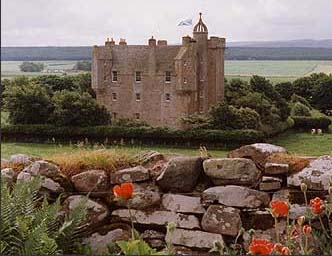A small family party of five people are standing on the westward bound platform in the historic town of Elgin Morayshire Scotland. The area was occupied by the Picts until the 9th century AD, when Kenneth MacAlpin united their lands with those of the Scots, and Pictavia acquired the name of Moravia (the Latin form of Moray). Moray was one of the seven traditional provinces of ancient Scotland (the ancient province covered a much wider area than the modern county). This province contributed two kings, Macbeth and Lulach (both 11th century), to Scotland. The ancient province of Moray ceased to exist in the 12th century, but the town of Elgin became the site of the Episcopal see of Moray in 1224. Robert I the Bruce of Scotland elevated Moray to an earldom and bestowed it upon his nephew, Thomas Randolph, in 1312. Many of the area’s villages were ravaged during the English Civil Wars of the mid-17th century. Moray was little affected by the industrial developments of the 19th century. The chief antiquities in the county are the remains of the cathedral at Elgin, Kinloss Abbey (1150), and Pluscarden Priory (1230).
Its 6am on a mild august morning the sun is still low in the east. My party of five made up of my wife Allison, daughter Julie and son Peter accompanied by my mother in law Mrs. Mary Brander we are heading west to Inverness the capitol of The Highlands there we hope to join the first train of the day out of Inverness to the Kyle of Lochalsh then take the ferry for the short crossing to the Isle of Skye before joining the bus from Kyleakin to Portree the capital of the misty isle. There was nothing odd about this trip if we were going by car or dare I say on an organized coach tour. A couple of times a year the local bus company do run day trips to Skye from Elgin. But we plan to travel all the way on public transport hoping to arrive in Portree in time for luncheon at the Bosvell Hotel. We hope to be able to make the return journey after lunch in Portree and back in Elgin for dinner all in the same day. I very careful checked and rechecked the times of the different modes of transport that we would be using during this trip in theory at least this trip should be achievable.
This journey is steeped in Scottish history often we shall be following in the footsteps of Bonnie Prince Charlie’s Jacobite army, we shall be learning more about William Shakespeare’s Macbeth the one all the modern day actors like to call the “Scottish play” our paths from time to time cross that of Boswell and Johnson who twenty seven years after the battle of Culloden made there tour of the Scottish Highlands. We hope to witness for ourselves the lasting effect that the defeat of the Jacobite army had on the Highlands of Scotland. Many were deported to foreign lands for being Jacobite supporters. After the battle of Culloden the Clan system broke down Highland Chiefs chose to clear there fellow clansmen off their ancestral lands. With the full support of The Police and the Kings army they were evicted off the land their homes burnt to the ground. This was often done at very short notice the poor clans man was hurried into packing up the small contents of his home and leave with his family often as the family were trying to pack up home the roof of their house was set on fire while they were still inside. The local clergy who was deep into the pockets of the local gentry proclaimed from the Kirk pulpit that the reason for this great calamity was that God was visiting them because of their sins. Those Highlanders who escaped deportation to the new world made their way to the cities were they tried to rebuild their lives. The lucky one’s who were left on the land lived in fear of the Highland Chief because they were left to do his biding.
As we board our train there is a mixed feeling of excitement and the unknown. Of interest from an operational point of view is that from Elgin to Inverness the line is still on token working. As after the train crosses over the river Lossie near Brucelands you can see glen Moray distillery founded in 1897 The original road into Elgin passes through the distillery grounds under the shadow of Gallow Hill, where executions were carried out until the end of the 17th century. This was an important road in times gone by and some of Scotland’s legendary historical figures including St Columba, King Duncan and Macbeth – after the Battle of Torfness – and Bonnie Prince Charlie are said to have passed along it. The next land mark is York Tower built in 1827 in memory of the duke of York and sat in its shadow is the former Mosstowie station closed in 1955. The next station is Alves this station was closed in 1965 in times past this was a very busy train station the former station has been converted into a private house and it is surrounded by former station buildings including the former railway men’s cottages. At one time this station was busy with livestock, timber, coal and grain. Carrots were sent for canning in Dundee sugar beet went to Cupar and milk went to Nairn and Inverness. The Royal train was often seen here during the time that Prince Charles was a pupil at Gordonstoun School. Just pass the station is the freight line to Burghead, which handles grain traffic, Our next station is Kinloss it was closed in 1965 here are good views of Findhorn bay and RAF kinloss a little closer to the former station is the ruins of kinloss Abbey founded in 1150 by King David I for a Cistercian order of monks from Melrose it fell into ruin after the reformation and its stones were later carried away by the laird of lethen. As the train approaches the out skirts of Forres you will see on your left Sueno’s stone. Just before the station is Mossest Park, home of the local highland league football team Forres Mechanics, who once had a goal keeper with a wooden leg! Forres is also home of the Dallas Dhu distillery. Until 1965 Forrest was the junction for the original Highland Railway main line over Dava moor to Aviemore. Forres is a very old burgh and like Elgin still preserves its medieval town plan.
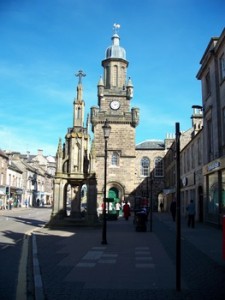
Forres High Street 2007
In 1773 Samuel Johnson and James Boswell spent the autumn touring the Highlands and Western Islands of Scotland On Friday 27th August they arrived in Forres
“We forwards the same day the Fores, the town to which Macbeth was traveling, when he met the weird sisters in his way. This to an Englishman is classic ground. Our imaginations were, heated, and our thoughts recalled to their old amusements”.
Leaving Forres train station we soon come to the Findhorn Viaduct unfortunately the boxed in design does not allow much of a view of the river Findhorn which is famous for its run of salmon and seatrout the bridge was designed in 1858 by Joseph Mitchell who was a native of Forres and had earlier worked with Thomas Telford on the Caledonian canal before following in his father’s John’s foot steps as chief engineer in charge of highland roads and bridges. His grandson Reginald Mitchell was the designer of the Spitfire fighter plane in World War II.
After we cross the Findhorn viaduct the train slowly increases speed as it heads towards the estates of Brodie Castle The castle itself is hide among the tree to the left however the train slows down as it approaches the level crossing that is just beyond the former Brodie Castle Station the station was closed during the short sighted Beeching era and the last train stop here in 1965 had the station remained open this would have proved ideal for the many tourist’s who visit the castle. As the train passes over the level crossing look out of left hand side of the coach after a line of trees a field opens into view then a wood. This used to be called Hardmoor and today is marked on the Ordnance survey explorer map number 423 as Hardmuir wood this is the site of the Heath of Macbeths weird sisters. The odd hand drawn map might name this area as Macbeth’s hillock. The land is part of the Brodie estate and is located in the old Parish of Dyke.
Brodie Castle is a typical fortified house built in the 16th Century and added to thereafter. The original house dating from 1567 was built by the 12th Brodie of Brodie. The original structure was a tower house built on a ‘Z’ plan with two towers set at opposite corners of a rectangular central keep. This gave defenders a field of fire along all four walls. A western extension was added in the early 17th Century but apart from this, little building was done until the 19th century when William Burn was commissioned to build the eastern wing of the house. The grounds of the castle were extensively remodelled in the 1730s with radiating avenues of trees, a wilderness and an ornamental canal and basin.
The earliest records of Brodies at Brodie date from over 800 years ago. The Thanes of Brodie inhabited the area and may have obtained their lands from King Malcolm IV in about 1160. The tenth laird living in the 16th century is the first of whom much is recorded. It was his grandson Alexander who began the building of the present house.
The Brodies lives were dominated by the religious events in the 17th century, the 15th Brodie signing the first National Covenant. This led to the castle being partially burnt in 1645 by Lords Gordon and Huntly. The 18th century saw the accumulation of considerable debt which later generations were to partially recoup by service in India. This burden of debt was to rear its head again in the 19th century when William Brodie (22nd) commissioned the eastern extension to the house. His marriage in 1838 to Elizabeth Baillie of Redcastle alleviated the situation somewhat. The 24th Brodie of Brodie was an authority on daffodils and raised at Brodie, many of the varieties we grow today. Ninian the present Chief of the Clan is the 25th Brodie of Brodie, He lives in a private wing of the castle continuing the 800 year association of Brodies with Brodie.
The train soon picks up speed and the Next train station down the line is Nairn. An old spa town and once the North’s most popular seaside resort. It has become internationally know for it excellent golf course. In times past Nairn was a thriving fishing community and the old fisher town, with its museum gives a good insight into former times. This is the former highland main line the rail way station is rebuilt from the 1855. the H plan design is similar to that of Pitlochry and Dingwall.
On the 28th August 1773 Samuel Johnson and James Boswell
“And next morning entered upon the road, on which Macbeth heard the fatal prediction: but we travelled on not interrupted by promises of Kingdoms, and came to Nairn, A Royal burgh, At Nairn we may fix the verge of the Highlands for here I first I saw peat fires, and first heard the Erse language”.
Three miles down the line we come to the former Cawder railway station in 1857 the station was renamed Kildrummie and sadly closed one year later so for a few years at least the station served the castle of its name.
On the 28th August 1773 Samuel Johnson and James Boswell
“We visited Cawdor Castle from which Macbeth drew his second title, it has formerly been a place of strength the draw bridge is still to be seen, but the moat is now dry”
The origins of Cawdor Castle and the Thanes thereof, go back to the middle Ages. The earliest part of the present castle, the central keep, was begun in about 1400. Sited for no particular tactical reason, it was nevertheless fortified as many medieval buildings were, as a place of refuge for a clan or group of kinsmen, from marauding bands (often neighbours or more distant kin!). From these early beginnings the castle grew in stages, successive generations of the family adding a room here and a building there Throughout the turbulent middle ages, by great good luck or judgement, the Thanes managed to be on the right side at the right time and retribution on their persons and property was, largely, avoided. The improvements to the castle were added with restraint and practicality, with the result that there is now a harmonious record of domestic and defensive architecture covering several centuries.
Little is known about the early Thanes of Cawdor. There is no evidence that Macbeth was one of them – the Shakespearean connection is tenuous, to say the least. The family survived through much skulduggery in the middle ages, becoming Campbell through a ‘cross-bow’ wedding to the Argyll-shire Campbell’s in 1510. The Campbell’s prospered acquiring lands in England and Wales and an Earldom. By the end of the nineteenth century, they were respectable enough to participate in Queen Victoria’s court. In more recent times the family have distinguished themselves as soldiers and sailors as well as in civilian service.
The train continues to the village of Gollanfield here the old military road passes through the village on its way to Fort George. After the Jacobite Rising of 1745, which ended with the battle of Culloden, the victorious Duke of Cumberland requested that a new fort be built at Inverness, on the site of the old. For various reasons the fort was built, not at Inverness but on a flat promontory projecting into the Moray Firth, some nine miles to the east of that town. The new fort, begun in 1748, the building was completed in 1770, although it had been defensible well before that. By this time the Highlands were pacified, as much by political, as by military means and the original purpose of the fort had become outmoded. When Johnson and Boswell passed this way they were wined and dined in grand style at fort George as they sat at dinner the windows were opened so the guests could enjoy listening to the garrison band playing in the court yard. When the train station first opened it was known as Fort George until the branch line opened in 1899 the station was renamed Gollanfield junction until 1959. The last public passenger train to fort George station was in 1943 however troop trains continued to run up to 1958 when the line closed. Gollanfield train station closed in 1965.
Three miles down the line is Dalcross this station was closed in 1965 and today is a private house and retains much of its former features. Over the past few years there have moves a foot in high places to reopen the train station as it would be ideal to handle traffic to the modern airport terminals. Dalcross Airport was built during the Second World War some time in 1943 four men left by plane and were parachuted onto a Norwegian glacier, carrying only the most basic equipment. Their mission was to prevent the Nazi regime from building an atomic bomb. In 1963 Dalcross was used as the film location for the “Dambusters” 617 squadron. With flying scenes of the Mosquito’s aircraft shot over Glencoe and the Great Glen.
As the train draws closer to Inverness it becomes more apparent that this area is steeped in history especially that pertaining to the House of Stuart Bonnie Prince Charles, the Jacobite uprising and Flora MacDonald, The old Clan system and The Highland clearances. Having passed fort George and Inverness airport on our right is the villages of Easter Dalzil and fisherton nestling on the edge of the moray forth then on your right and in full view is castle Stuart Castle Stuart became a derelict ruin for almost 300 years. It remained empty – except for the ghosts. Today Castle Stuart has been restored and is run as a hotel.
CASTLE STUART
Throughout centuries of Scotland’s troubled history, Castle Stuart has stood a strong refuge and retreat for the Earls of Moray and the Stuart family. Within sight of this great house on high Culloden Moor, the Highland Broadsword rose and fell in the last futile attempt to restore the exiled Stuart kings to the British throne
Charles Edward Stuart shared with the Lords of Castle Stuart a proud descent from the Royal House of Albany, rulers of Scotland and, for a time, of the United Kingdom. The Stuarts and their kin wrote much of the bloody and poetic history that is Scotland’s heritage at the time of the Battle of Culloden Castle Stuart was a ruin. And unable to offer Bonnie prince Charlie shelter.
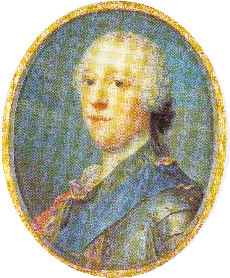
b 1720 – 1788 d.
On our left on the hill Stands Culloden house at the time of the Jacobite rising in 1745-46, Culloden House was requisitioned by Bonnie Prince Charlie and used as his lodging and battle headquarters prior to that fateful and final battle on Culloden Moor on the 16th April 1746.
High on the moor and out of view from the train carriage windows is Drummossie Muir the site of the Battle of Culloden the Scene of the last major battle fought on mainland Britain. The final Jacobite uprising ended here on 16 April 1746. The army of Prince Charles Edward Stuart was crushed by the Government forces, led by the Duke of Cumberland. This was a bloody battle that latest less than an hour.? On the battle field the Jacobite army lay dead or wounded.
On the road to Inverness packed with fugitives, one of the ugliest chapters in British history had opened. The Duke of Cumberland gave his men orders “that no quarter was to be given” Cumberland’s dragoons slaughtered indiscriminately not only fleeing clansmen, but innocent bystanders including women and children. On the battlefield The Red coats bayoneted or clubbed to death the wounded of the Prince?s army often obscenely mutilating the bodies
Its aftermath was to affect the whole future of the Highlands. What little remained intact of the Princes army withdrew In good order under Lord George Murray towards Ruthven, in badenoch the following day the prince sent word that it “was every man for himself” The Prince himself felled the battle field with a close group of loyal supporters and made there was to Faillie, through strathernairn and stratherrick Heading for the road to the Isles.
As the train heads towards Inverness looking across the Moray Firth there is the Black Isle and eventually the Kessock Bridge. On the approach to Inverness is the junction with the line from Perth and shortly the train runs into the station
“Failte do’n Ghaidhealtachd”
Welcome to the Highlands
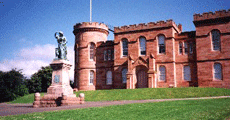
Inverness castle with Flora McDonald statue looking down the river ness
The Royal burgh and seat of Inverness district, Highland region, Scotland. It is the long-established centre of the Highlands and lies at the best crossing place of the River Ness, which flows from Loch Ness at the east end of Glen More. Situated astride the river and the Caledonian Canal, it commands the route system of northeastern Scotland.
Inverness was the capital of the Pictish kingdom of King Brude, who was visited and converted by St. Columba c. 565. By the 12th century Inverness had become a burgh nestling under the castle attributed to King Malcolm III Canmore, which remained a royal residence and fortress for centuries.
Here is a castle of Macbeth The present 19th-century castle overlooks the river and, on the site of a fortress destroyed in 1746 by the Jacobites, now houses law courts. The few old surviving buildings include the old Town Cross (1685), the Town Steeple (formerly a prison), the old High Church (1769-72), and St. Andrew’s Cathedral (1866-71).
At Inverness we join the Inverness to the Kyle of lochalsh train a distance of 63 miles this is one railway journey which should be experienced at least once in a life time. Whatever time of year. In summer when the moors are covered in purple heather, or winter when the mountains and moors are blanketed with deep snow.
Shortly after leaving Inverness station we cross the viaduct over the River Ness and then slow to walking pace to cross a swing bridge over the Caledonian canal, the waterway built by Thomas Telford early in the nineteenth century the train then speeds along the shores of the beauly firth, (Beautiful Place), On the right hand side of the train you can we see a variety of bird life including grey herons, swans and geese and on through a landscape of barley and oilseed rape. The line turns north at the head of the Firth, and the turrets, rising just above the trees, of Beaufort Castle, the clan seat of the Fraser’s.
Descending into the wide valley of the River Conon (the dog river), the massive Ben Wyvis (big noble Mountain) towers above, rising to 3,433 ft with a top plateau of 4 miles long. Crossing the River Conon, the valley floor opens out and ahead, on the right, the Cromarty Firth offers our last view of the North Sea.
Beauly village whose station is closed our first train station is Muir of Ord; Barley is brought by freight train to the Muir of Ord to supply local distillers. The line drops to cross the river Conon, which flows into the Cromarty Firth, and Shortly arrive at Dingwall, The train slows as we reach Dingwall, supposed birthplace of the much maligned King Macbeth. Norse in origin, the name Dingwall comes from Ting (parliament) and Voir (Valley). From here, a thousand years ago, the Vikings governed the north.
Dingwall is the old county town of Ross and Cromarty. The town has a population of 4000 and nestles at the foot of Ben Wyvis. As the train pulls out of the station look out for the remnants of a once thriving railway goods-yard, the coal yard and livestock pens now silent and abandoned.
As our train leaves Dingwall and climbs slowly up the 1:50 incline to Raven Rock, you will discern in the distance the spa village of Strathpeffer which once boasted a branch line of its own. Nearing the summit you notice the dramatic contrast between the agricultural lowlands to the east and the rugged mountainous lands to the west.
After leaving Garve we past several hydro-electric dams and generating stations as you pass you might see salmon leading the purpose built fish ladders on their way to spawn up stream
The train proceeds at a leisurely pace to Achnasheen, a bleak and lonely place once heavily covered in Scots fir trees which were felled during the First and Second World War by men from Honduras. This was also a favorite place for our own armed service men to be trained in survival skills before being sent behind the enemy front line. But for the railway, Achnasheen small as it is would not exit. In the days of steam the engines took on water here and the up and down trains passed each other. Some trains still pass each other here.
Leaving Achnasheen we cross the watershed at a height of 634 feet. From here the streams flow to the west rather than the east coast. Along this section you will see the abundant wildlife particular deer and birds of many species including the occasional eagle. Indeed amid so desolate a landscape you are left to wonder what happened to the clansman and their families who once lived in this wilderness. Heading for Achnashellach we pass the Torridon peaks. Clinging to these mountains are the remnants of the primeval Caledonian forest which covered the Highlands long ago.
Our train than heads towards Strathcarron train station here the railway line follows the main A890 road. Where we meet the waters of Atlantic as the train shirt the southern shores of Loch Carron, with its numerous rocky inlets. Here the interplay of light and shadow upon the loch, reflecting small islands, cliffs and towering mountains, cannot fail but impress the traveler. Whatever the weather. Or time of year. Passing the village of Achintee our next stop is Attadale train station.
We soon arrive at Stromferry train station. It was here that the railway line originally ended. It was not extended to Kyle until 1897 twenty years later. This latter 10 mile section was the hardest to build, much of it blasted out of solid rock. At the cost of £20,000 per mile. It was the most expensive piece of railway engineering under taken at that time. Looking across loch Carron you can see Strome Castle. standing in the shadow of “Bad A Chreamha” its summit is just 394 feet above sea level.
Soon after leaving Stromeferry station the railway line continues to hug the southern shoreline of Loch Carron looking across Loch Carron you will see Kishorn Island standing at the mouth of Loch Kishorn The on our right is the village of Plockton and the fine views of Wester Ross over the bay of Loch Carron.
As our train leaves Plockton station we make our way to Duirnish train Station. As we reach Duirnish Station there are fine views of Crowlin Islands. Duirnish is the last train station before the Kyle of Lochalsh As the train leaves Duirnish station
We slowly make our way along the coast line between the villages of Drumbuie and Badicaul there are fine views of Longay Island and Pabay Island, Scalpay Island, and the Island of Rassay, and The Isle of Skye all these Islands from the Radio Amateurs point of View are on the operating list for the Islands of Scotland Award. The Isle of Skye is also listed on the Islands on the air IOTA for short run by the Radio Society Great Britain.
The Kyle of lochalsh is a village with a population of about 700 inhabitants As the Train arrives at the station. There is a sense of excitement among our fellow’s travelers for many this is not journeys end but the gate way to visiting many of the Scottish Islands As you alight from the train at Kyle with the smell and tang of the sea in the air, with the cry of the gulls and the sound of busy ferries loading before crossing over the sea to Skye. You will wish to savour this journey again.
The Isle Skye is the largest and most northerly island of the Inner Hebrides; it is the nearest of these islands to the Scottish mainland, being separated at the Kyleakin ferry crossing by only a few hundred yards. Administratively it is part of Skye and Lochalsh district, of Highland region. Skye is almost 50 miles (80 km) long and is so deeply indented that no part is more than 5 miles from the sea. The Cuillin Hills (rising to 3,257 feet [993 m] above sea level) dominate the landscape in south-central Skye. North of Portree, seat of the district authority, is the curious basaltic group of pinnacles at Storr, the most remarkable of which, the Old Man of Storr, is a landmark for sailors.
Much of Skye is moorland. The crofting system is still widespread. During the late 18th and early 19th centuries, the poverty of the crofters was extreme, and large numbers were forced to emigrate. Improvements came after the passage of the Small Landholders (Scotland) Acts, 1886-1911, and the subsequent introduction of government subsidies for growing potatoes and raising cattle and sheep. The fishing industry, once a mainstay of the economy, has declined. Other occupations include whisky distilling at Carbost and, just north of Storr, the reworking of extensive diatomite deposits, with a processing plant at Uig. Tourism is a major industry. Portree lies at the head of a fine harbour on the eastern coast and manufactures tweeds, tartans, and other woolens.
Skye was ruled by Norsemen until the 13th century, when the Hebrides became part of Scotland. Dunvegan Castle, home of the MacLeods, the chief clan of Skye, was built in the 9th century and has been occupied longer than any other house in Scotland. Gaelic is widely spoken in the island’s
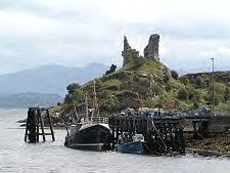
Moil Castle
Leaving the train station we walk over to the ferry terminal taking the short car ferry trip over to the Isle of Skye landing at Kyleakin. Kyleakin is the gateway to Skye. The main ferry crossing from Kyle of Lochalsh connects with the slipway at the east end of Kyleakin: as a result the village is always a busy place, and at times it can be a crowded one. Though Kyleakin has a history as old as its castle, most of what you see today dates back to a planned village created in 1811, creating, in most visitors eyes at the time, the most attractive settlement on Skye.
There is plenty of time to explorer the small harbour and to take a walk up to the Castle Moil with its views over Loch Alsh. Castle Moil is Kyleakin’s own castle, the stumpy remains of a 15th Century keep, parts of which collapsed in 1989. It was allegedly built for a Norse princess who married a MacKinnon chief. It was designed to help enforce tolls on ships passing through Kyle Akin, separating Kyleakin from Kyle of Lochalsh on the mainland, and part of the coastal route avoiding the much longer and more exposed journey around the seaward side of Skye. The ruins of the castle are now relatively secure.
There is plenty of time to pause and reflect much of our journey since living Elgin has been following in the foot Steps of Bonnie Prince Charlie who after the battle of Culloden was fleeing Butcher Cumberland’s army. Things were now getting very hot for the Prince. He had been close to capture on the Island of Calvay, and Hugh McDonald of Armadale Flora McDonald’s stepfather was hunting him in south uist with a company of McDonald militia. Some of the Skye McDonald’s and McLeod\’s had thrown in their lot with the government, but like many others, Hugh McDonald loyalties were divided, and it was he and MacEachain, who devised a plan to get the prince out of immediate danger and away to the Isle of Skye. By this time bonnie Prince Charlie was in hiding at Loch Uskevagh. Accompanied by, Edward Burke, O’Sullivan and O’Neill and Malcolm McLeod. Who had shared all of the Prince’s hardships since Culloden.
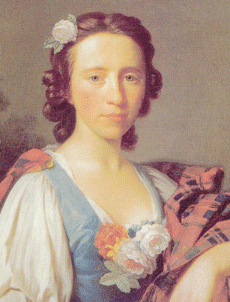
Flora McDonald\’s stepfather was an officer in the militia but it was he who provided the official passes for Flora\’s Journey. The pretext being that South Uist was becoming too dangerous. A part of Hugh McDonald of Armadale escape plan, which has passed into the folklore of the \’45 was that the Prince should be dressed in female attire and presented as Betty Burke, Flora McDonald\’s Irish maid. In a letter dated 22 June 1746 and signed by Hugh McDonald.
I have sent you my daughter from this country lest she be in any way frightened by the troops lying here. She has got with one Betty Burke an Irish girl, who, as she tells me is a good spinster If her spinning please, you can keep her, you can keep her until she spins all your lint. Or if you have any wool to spin, you may employ her. I have sent Neill MacEachain along with your daughter and Betty Burke to take care of them.
I am your dutiful husband.
Hugh McDonald 22 June 1746.
On 28th June 1746 Prince Charles Edward Stuart said farewell to Edward Burke, O\’Sullivan and O\’Neill these three escaped. Malcolm McLeod was later captured by Campbell?s militia. Bonnie Prince Charlie embarked for Skye dress in a calico gown over a quilted petticoat, and wearing a very becoming frilly bonnet. His companions were Flora McDonald, Neill MacEachain, John McDonald and Alexander MacDonald, and two boatmen.
They soon ran into rough weather and the prince regaled them with songs to keep their spirits up. The best remembered of these is The King shall Enjoy His Own Again, an old song even for then. In the early hours of the 29 June they passed Vaternish point on the extreme north west of the island and sailed across Loch Snizort to land just north of Kilbride at a place still known as Prince Charlie’s point.
In contrast 27 years later. Johnson And Boswell Are on their Scottish tour of the highlands On 2nd September 1773 Johnson And Boswell leave Glenelg by boat and sail down the sound of sleat and land at Armadale on the Isle of Skye. Johnson recalls we landed at Armidel, where we were met on the sands by Sir Alexander Macdonald who was at that time there with his Lady, preparing to leave the island and reside in Edinburgh. Armidel is a neat house, built where the Macdonald\’s had once a seat which was burnt in the commotions that followed the revolution. Sir Alexander was educated at Eton and at table we were entertained according to the ancient usage of the North with the melody of the bagpipes. I call any one a Highlander who speaks the Erse language, or retains the primitive manners.
Johnson also noted that it was in sky that he first saw anyone wearing Brogues In the highlands the plaid is very rarely warn the filibeg or lower garment is still very common, and the bonnet almost universal
Leaving the Castle of moil I rejoin my party which is made up of my Wife Allison, daughter Julie, son Peter and my mother in Law Mrs. Mary Brander of Elgin Morayshire. We take the bus from Kyleakin to the capital of the island Portree as the bus winds it way slowly along the A850 towards Broadford. I can clearly see the islands of Pabay, Longay, Gulliamon, and Scalpay.
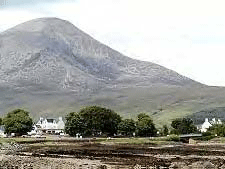
Broadford
The bus soon arrives at Broadford Skye\’s second largest settlement, Broadford, lies in the shadow of the Red Cuillins and spreads itself along the southern side of Broadford Bay. Views extend out to the Isle of Pabay and more distantly to the Applecross mountains on the mainland. Broadford\’s origins date back to a cattle market in the late 1700s, and in 1812 the road from Kyleakin to Portree was built by Thomas Telford through the village. It grew rapidly with the settlement here of Napoleonic veterans after 1815, and at about this time it had a brief-lived distillery. Leaving
Broadford we are Soon passing Loch Ainort and the Crofters house museum. As the road follows the eastern edge of the Cuillin hill also called The Coolins, or Cuchullins, mountain range, south-central portion of the Atlantic coastal island of Skye, Inner Hebrides island group, Highland region, Scotland. The mountains are among the most precipitous in the United Kingdom and include 15 peaks above 3,000 feet (900 m). There are two main ridges – the magnificent Black Cuillins, some peaks of which remained unclimbed until the late 19th century, and the Red Cuillins around Loch (lake) Coruisk to the south. we pass Sconser and travel along Loch Sligachan and follow the road through Glen Varragill. The scenery is breath taking. And I give thanks to a loving GOD who created the World so that we can enjoy the wonders of creation.
When the small boat that was carrying Bonnie Prince Charlie landed at Prince Charles point on 28th June 1746 the plan was to go to Monkstadt house the home of Sir Alexander McDonald Flora and MacEachain went on ahead, but they found that the place was full of militia men searching for the prince. By good fortune McDonald of kingsburgh was visiting Monkstadt and made his excuse to leave and arranging to meet Bonnie Prince Charlie who took him to his own house at Kingsburgh with the idea of taking him on to Portree. The rest of the evening was spent at Kingsburgh house and the “bottle flowed” Next day the group woke late.
We were soon at the head of loch Portree with clear views on our right of the island of Rassy. Our small party was enjoying the lovely scenery and looking forward to arriving at Portree. We were not to wait long before the bus arrived in Portree. The capitol of the misty Isle was buzzing with tourists from all over the world most clutching some kind of Highland souvenir a small trophy to remind them of their visit. It was just great watching them soaking up the atmosphere. After all in part we were doing the same Tourist’s in our own home land.
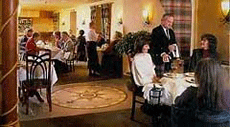
We made our way along the high street towards the Harbour and to The Bosvell Hotel I had all ready pre-booked a table for our party of four and a young waitress led us to our table. Portree is the main town on Skye. Its name comes from the Gaelic “Port-an-Righ”, which translates as “King\’s Port” and dates to a visit by King James V, plus a fleet of warships, in 1540, to persuade the island clans to support him. It had earlier been known as Kiltraglen. Although Portree dates back to 1540, very little seems to have been built here until the latter half of the 1700s, We dine on Scottish broth soup, followed by the main course of Scottish roast beef. Potatoes, carrots, and peas, washed down with a fine bottle of claret. Dessert followed Clutie dumpling and cream. When we had finished dinning the waitress cleared the table and over pots of coffee. We discussed our common ancestry. Leaving the hotel we continued to explore Portree.
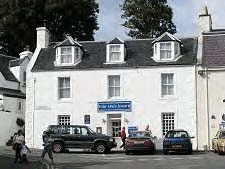
The main street running parallel to the back of the harbour is Bank Street. This is perhaps best known for the Royal Hotel. In an earlier guise, as MacNab’s Inn, this was where Bonnie Prince Charlie bade farewell for the last time on the 1st July 1746 to Flora MacDonald, who had famously conveyed him “Over the Sea to Skye”. Before they parted he have her a lock of his hair which is among one of the relics at Dunvegan Castle. As they parted Charles in tears kissed her hand and Said “For all that has happened, Madam, I hope we shall meet in St James Yet” The Prince left in a rowing boat accompiend by Captian Melcom Mcleod, the nephew of Mcleod of Rasssay.
Flora MacDonald was arrested on her way home as were Kingsburgh and his wife and daughter. Kingsburgh was first placed in irons at Fort Augustus and the taken to Edinburgh Flora was transported by ship to London and imprisoned. She was put on board the Furnace where MacLeod of Gualtergill, father Allan MacDonald were also confined. It was said that Flora’s fortitude and calm manner under questioning in London won her much respect and admiration so by the time she was released under the general amnesty a year later Flora MacDonald had become a heroine. And returned home to the Isle of Skye.
As for the Bonnie Prince Charlie he was to hiding on the Island of Raasay. leaving by boat To Land on Skye at a place called Nicholson\’s rock on Trotternish feeling over land to Elgol only to leave by rowing boat and made his way to the main land of Scotland they were on the south side of Loch Nevis by the following morning after three days they made there way up the coast. Landing in Knoydart always follow in hot pursuit by the kings government troops. The prince continued on into Glen shiel, loch Cluanie, and Glen affric. Between the 2nd-13th September The Prince was hiding in cluny\’s cage on Ben Alder. Charles Edward Stuart Felt safe at Ben Alder as he had also done at Corodale in South Uist but when a messenger arrived on the 13th September to say that there were French ships seeking him on the west coast. He and his companions left immediately. They went by Glen Spean and Glen Roy and Crossed the river Lochy to spend the night of 16th September at the ruined home of lochiel, by Loch Arkaig.
In the mean time Government ships were scouring the east coast. On 19th September The Prince\’s party arrived at Loch Nan Uamh to find two French ships awaiting them. Charles Edward Stuart was taken on board “Le Coont”i and was later transferred to “L\’Heureux”, with lochiel and his brother Dr Cameron. While Cluny McPherson left to make his way back to Ben Alder he lived in the cave for a further nine years before leaving for France. Dying one year later. In the very early hours of 20th September 1746 Prince Charles Edward Stuart sailed out of loch Nam Uamh out of Scotland and into legend.
Flora McDonald spent one year in prison in Lodon and returned home to Skye She married Young Allan McDonald at Armadale Castle in 1750 There family home at the time of Johnson and Boswell visit was Kingsburgh.
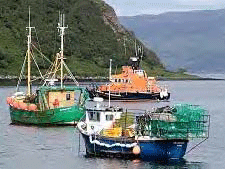
On Sunday 12th September 1773 Johnson and Boswell…we reached the harbour of Portree in sky, which is a large and good one There laying in it a vessel to carry off the emigrants, called the Nestor It made a short settlement of the differences between a Chief and his Clan we approached her and she hoisted her colours Dr Johnson and Mr M’Queen remained in the boat Rasay and I and the rest went on board her she was a very pretty vessel and as we were told the largest in the Clyde. Mr Harrison the captain shewed her to us the cabin was commodious and elegant there was a little library finely bound
Wrote James Boswell
Johnson and Boswell dinned at the Inn in Portree 27 years earlier this same Inn was were Bonnie Prince Charlie said Farwell to Flora McDonald. Here they found letters from home. They left latter that day to stay at Kingsburgh the home of Young Allan McDonald and his wife Flora McDonald Kingsburgh was completely the figure of a gallant highlander exhibiting the graceful mien and manly looks. He had his tartan plaid thrown about him, a large blue bonnet with a black ribband like a cockade a brown short coat of a duffel, a tartan waistcoat with gold button-holes a bluish pilibeg and tartan hose. He had jet black hair tied behind and was a large stately man with a steady countence.
Boswell described Kingsburgh wife thus “the celebrated Miss Flora MacDonald she is a little women of genteel appearance and uncommonly mild and well bred”
While Dr Samuel Johnson said “Mr MacDonald and His Lady Flora MacDonald a name that will be mentioned in history and if courage and fidelity be virtues, mentioned with honour”.
Portree saw other sad departures later in the 1700s, when Skye folk, fleeing poverty and overpopulation, boarded ships bound for North America. Boswell, on his tour of the highlands 27 years later in 1786 noted: “Last year when the ship sailed from Portree for America the people on shore were almost distracted when they saw their relations go off. This year not a tear is shed.
As we stood on the beech at Portree harbour We pondered the great questions of time After the Prince fled to france he was to live for another 42 years the Royal Stuart line continued until the death of Henry IX Cardinal Duke of York who died in 1807.
For the highlander the following years after Culloden were grim since the battle, the gaols and prison hulks had been filled to overflowing there were 3,470 known jacabite prisoners 120 were excuted four were peers of the realm who were beheaded. including 38 deserters from the British army and two spies suffered the barbaric ritual of hanging drawing and quatering 936 were transported to the colonies to be soild as slaves 222 were banished and free to choose there country of exile 1,287 were released or exchanged others died or escaped or pardoned and there were nearly 700 whose fates could not be traced.
But this was far from the end The Goverment feared The Highlander and came up with the disarming act all weapons were to be surrendered this included the bagpipes The Highland identy in dress was prohibited the wearing of tartan the great plaid the kilt or any part whatever of the highland garb the penalty was six months in prison on the second offence transportation for seven years.
The Heritable jurisdiction Scotland Act of 1747 It removed from the Clan Chiefs the hereditary power to impose punishments of imprisionment or even death. thus they became over night ordinary Landlords. their wealth had been reckoned in men now with the dissolution of the Clan system men were no longer important. Soon to follow whats called in the Gaelic phrase “the days when sheep ate men” During the days of the clearances the people were driven out by the landlord many were Clan Chief.
Thier departure was Britian’s loss, but an immeasurable gain to those countries beyond the seas to which they travelled, and from which, generations later, returned on a pilgrimage to a proud past.

